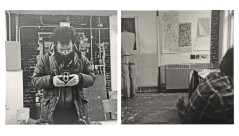A sketchbook drawing of Robert’s Argyle Street studio reveals a row of arch-shaped windows spaced along a red brick wall. Floorboards run underfoot in parallel lines. Here Robert has abstracted these elements into a row of arches, striped lines and an irregular island or oasis shape. The artist’s studio is both an oasis, a safe haven for creative ideas, and a place where images are produced that may not be what they seem—a mirage factory.
Plato claimed images were illusions of illusions, based on faulty perceptions of the ever-changing natural world. To illustrate his idea, Plato invented the parable of the cave. Robert’s windows resemble caves. He has introduced a series of shadows, which may be a further reference to Plato’s famous story. Robert’s image is a painting about painting and its philosophical mission.
A debate raged in the art world at this time that questioned how painting could be used as a medium for telling truths when all its images were based on illusions. It’s a debate that never goes away. There’s a well-known quote attributed to Picasso: “Art is a lie that tells the truth.” What Picasso actually said in an interview with American critic Marius de Zayas and published in Arts magazine in 1923 was: “As we say in Spanish: love must be proved by facts and not by reasons. What one does is what counts and not what one had the intention of doing. We all know that Art is not truth. Art is a lie that makes us realize truth, at least the truth that is given us to understand.”



